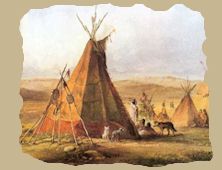 |
Native American Nations
Your Source for Indian Research Rolls ~ History ~ Treaties ~ Census ~ Books |
 |
Native American Nations
Your Source for Indian Research Rolls ~ History ~ Treaties ~ Census ~ Books |
|
|
Moxus Moxus, or as he was sometimes called
Agamagus, was also a noted chief. We can add little concerning him to what
has already been said. After Madokawando was dead, and the war between the
French and English nations had ceased, the eastern chiefs were ready to submit to
terms. Moxus seems the successor of Madokawando, and when delegates were
sent into the eastern country to make peace with the Indians, in 1699, his name
stood first among the signers of the treaty.1 He concluded
another treaty with Governor Dudley, in 1702. The next year, in company
with Wanungonet, Assacambuit, and a number of French, he invested Captain March
in the fort at Casco. After using every endeavor to take it by assault,
they had recourse to the following stratagem. They began at the water's
edge to undermine it by digging, but were prevented by the timely arrival of the
armed vessel under Captain Southack. They had taken a vessel and a great
quantity of plunder. About 200 canoes were destroyed, and the vessel
retaken. From which circumstances it may be inferred that their number was
great. Whenever was commenced between
the English and French in Europe, their colonies n America were involved
in its calamities, to an unknown and fearful extent. This was the
aspect which affairs were in 1703. With the first news, therefore,
of its flame, the New Englanders' thoughts were turned towards the
Indians. Governor Dudley immediately dispatched messengers to most
of the Eastern tribes, inviting them to meet him in council upon the
peninsula in Falmouth, on the 20 of June. His object was so to
attach them to the English, that , in the event of hostilities between
the rival powers on this side of the Atlantic, they would not take arms
against them. Agreeably to the wishes of the English, a vast
multitude assembled at the time appointed: the chiefs Adiwando and
Hegan for the Pennakooks, Wattenummon for the Pequakets, Mesombomett and
Wezar for the Androscoggins, Moxus and Hopehood (perhaps son of him
killed by the Mohawks) for the Nerigwoks, Bomazeen and Captain Samuel
for the Kennebecks, and Warrungunt and Wandugunbuent ofr the Penobscots.
After a short speech to them in which the governor expressed brotherly
affection, and a desire to settle every difficulty "which had happened
since the last treaty," Captain Simmo replied as follows: 1. Hubbard,
Ind. Wars, ii.46 This site includes some historical materials that may imply negative stereotypes reflecting the culture or language of a particular period or place. These items are presented as part of the historical record and should not be interpreted to mean that the WebMasters in any way endorse the stereotypes implied. Drakes Indians of North America
|
|
|
Copyright 2000-2019 by NaNations.com and/or their author(s). The webpages may be linked to but shall not be reproduced on another site without written permission from NaNations or their author. Images may not be linked to in any manner or method. Anyone may use the information provided here freely for personal use only. If you plan on publishing your personal information to the web please give proper credit to our site for providing this information. Thanks!!! |